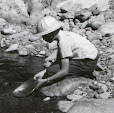We've seen this before and what a fight
it was last time!
The current Gold and Fish
pamphlet containing the rules for mineral prospecting and placer
mining was developed in 2008 and took effect in April, 2009.
Significant input from the Small Scale Prospecting and Mining
Community had a large impact in making the rules workable, if not
altogether ideal, for miners. It now appears that the rules are
about to change again for the worse unless we take immediate action.
One disturbing aspect of this change is
the announcement in an email from the
Resources Coalition that WDFW
is no longer seeking the cooperation of the Small Scale Prospecting
and Mining Community in the development of the new rules that is now
underway. Below is the Resources Coalition email reproduced with
permission:
 |
| Click above images to enlarge. |
As mentioned in the above email, WDFW
has scheduled a public meeting to focus on the proposed changes to
the mineral prospecting and placer mining rules. When and where is
as follows for this event:
When October 23, 2013 6:00 P.M. to
8:00 P.M.
Where Natural Resources Building
Capitol Campus
NRB Room 172
Olympia, Wash.
Some of the proposed changes that are
outlined in the HYDRAULIC CODE RULE CHANGES Draft Programmatic
Environmental Impact Statement are the following:
Existing WAC Numbers: WACS
220-110-200, 220-110-201, 220-110-202, 220-110-206 are to be replaced
by Proposed WAC Number: WAC 220-110-300. The document notes on page
35 that,
The rules adopted by the Washington
State Parks and Recreation Commission allowing certain beach
prospecting activities in marine waters are covered by the Gold
and Fish pamphlet so an individual HPA to legally prospect on
ocean beaches is not required. Timing change to the Nooksack and
Wenatchee Rivers reflect the results of spawning surveys.
(Emphasis
added.)
Multiple sections have been
combined. A new section on mineral prospecting on ocean beaches has
been added, including where beach prospecting may occur and what
equipment may be used. General requirements for mineral prospecting
are included in the Gold and Fish pamphlet. Authorized work
times for mineral prospecting in state waters have been changed and
are listed in a table.
(Emphasis added.)
On page 47 we learn that the Existing
WAC Number WAC 220-110-020 is to be replaced with the Proposed
WAC Number WAC 220-110-030 and that,
Definitions have been separated into
three categories: general terms, mineral prospecting specific terms,
and aquatic plant removal and control specific terms. Existing
definitions have been updated and new
definitions have been added. (Emphasis added.)
The present author has not had time to
scour both old and new lists of definitions but would caution that
significant changes could lurk there.
On page 97 of the Draft EIS we are
treated to a list of the Potential Impacts to Fish Caused by
Mineral Prospecting:
-Injury/mortality
-Degraded physical habitat (spawning
substrate)
-Reduced prey availability
-Reduced productivity
Please note that
all of these “potential impacts” are probably as speculative as
they sound since no credible data are presented that any of them
actually result from small-scale mineral prospecting or mining.
Please note further that all of these impacts are of a negative
nature, omitting such reported benefits to fish as mercury removal from
streams that occurs as a result of suction dredging.
In any event, there
is much to contest here and members and supporters of the Small Scale
Prospecting and Mining Community are well advised to attend the
Olympia meeting in droves lest we find our property rights and
livelihoods steamrolled by environmental special interests.
Comments on the
Draft EIS must be received by WDFW no later than 5:00 P.M. on
November 15, 2013. WDFW states that,
You
can submit your comments any one of the following ways:
Email
to SEPAdesk2@dfw.wa.gov
Online
at the WDFW SEPA website comment link at:
http://wdfw.wa.gov/licensing/sepa/sepa_comment_docs.html
Fax
to (360) 902-2946
Oral
or written comments at the workshops and public meetings
(As on 10/23/13 - Emphasis
added.)
Mail
comments to SEPA Responsible Official:
Bob
Zeigler, SEPA/NEPA Coordinator,
600
Capitol Way North,
Olympia,
WA 98501-1091
When
you send us your comments, please include the name of the proposal
and your name in the subject line of your comment, following this
example:
Re:
Hydraulics Code Rule Changes Draft PEIS - Your Name
For
those interested, the Draft EIS and the proposed Chapter
220-110 WAC
HYDRAULIC
CODE RULES are available at
the link here under “Downloads” at the top of the box in the
right-hand column.




